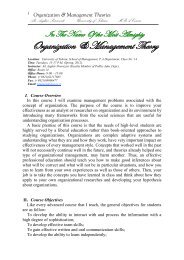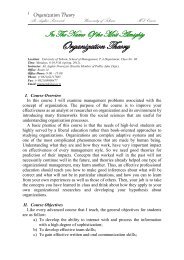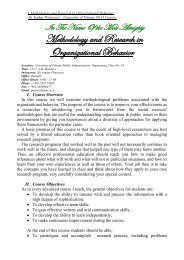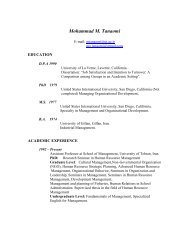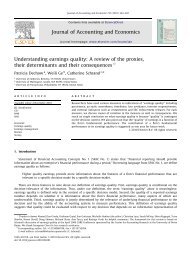Evaluating organizational stress-management interventions using ...
Evaluating organizational stress-management interventions using ...
Evaluating organizational stress-management interventions using ...
Create successful ePaper yourself
Turn your PDF publications into a flip-book with our unique Google optimized e-Paper software.
EVALUATION OF INTERVENTIONS 29<br />
experience of work <strong>stress</strong> (work-related well-being) was measured <strong>using</strong> the<br />
exhaustion scale of the General Well-Being Questionnaire (GWBQ; Cox &<br />
Griffiths, 1995; Cox, Thirlaway, Gotts, & Cox, 1983). This measure was<br />
used as the dependent variable to examine the likely impact of the<br />
intervention on work-related well-being. The exhaustion scale is a 12-item<br />
self-report measure of nonspecific symptoms of general malaise relating to<br />
fatigue, cognitive confusion, and emotional irritability. It has been shown to<br />
be sensitive to the fluctuations in well-being associated with the emotional<br />
experience of <strong>stress</strong> at work (Cox & Gotts, 1987; Cox et al., 1983).<br />
Participants recorded their experience of these symptoms <strong>using</strong> a 5-point<br />
frequency scale of 0 (never) to 4 (always) with a time window of<br />
measurement set as the preceding 6 months: The higher the participant’s<br />
score on the questionnaire, the ‘‘poorer’’ their well-being. The scale was<br />
found to be reliable in both studies (Cronbach’s alphas: preintervention<br />
= .82 (Study 1) and .85 (Study 2); postintervention = .89 (Study 1) and<br />
.83 (Study 2). Examination of the standard errors for skewness and kurtosis<br />
showed that scores were normally distributed at both measurement points.<br />
Existing data shows that for employees in managerial posts the normative<br />
score on this measure is approximately 17 (Cox & Gotts, 1987; Cox et al.,<br />
2000). Preintervention, both participant groups appeared more exhausted<br />
than the normative group (mean Study 1 = 20.3, SD = 8.7; mean Study<br />
2 = 18.9, SD = 7.5). These high levels were, in part, justification for both<br />
risk <strong>management</strong> projects.<br />
Measures of intervention exposure were taken at Time 2 and were<br />
designed to tap into the active ingredient of the each intervention, i.e., the<br />
aspect of exposure hypothesized to be the driver of change (Kompier,<br />
Cooper, & Geurts, 2000b) in exhaustion scores. In Study 1, the active<br />
ingredient was awareness of the new guidelines and procedures for fault<br />
reporting. It was predicted that being aware of the new guidelines would<br />
make a difference. Participants were asked to indicate their awareness of<br />
(exposure to) the intervention through a single dichotomous item: ‘‘Indicate<br />
whether or not you are aware of: the return of fault reporting to your<br />
control’’ (0 = ‘‘No’’, 1 = ‘‘Yes’’). To test their reliability and validity these<br />
data were triangulated. Senior managers (n = 3), and a sample of the<br />
managers responsible for implementing the intervention (n = 6) were asked<br />
to comment on its implementation. Records of written communications<br />
were also examined for evidence of implementation.<br />
In Study 2, the ‘‘active ingredient’’ was involvement in the programme of<br />
updating computer equipment in the wards (i.e., a measure of whether each<br />
participant had used new computer equipment recently installed in their<br />
ward). Participants were asked to indicate their involvement in the<br />
intervention through a single dichotomous item: ‘‘Indicate whether or not<br />
you have been involved in: the use of new computer equipment in your




